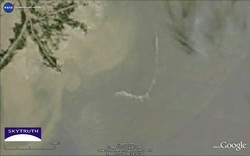Foreign oil interests still fouling Louisiana's coastal waters
 At the same time President Obama was being blasted as a "traitor" for his administration's deference to BP in the wake of last year's Gulf oil disaster, another spill involving South Korean-owned companies was contaminating Louisiana's coastal waters.
At the same time President Obama was being blasted as a "traitor" for his administration's deference to BP in the wake of last year's Gulf oil disaster, another spill involving South Korean-owned companies was contaminating Louisiana's coastal waters.Obama came under harsh criticism last week over his handling of the BP spill from the actor Peter Fonda, who was at the Cannes film festival in France for the premiere of "The Big Fix," a documentary about the Gulf disaster that he co-produced.
Fonda appears in the film trying to visit Louisiana beaches to see the spill's impact only to be turned away by BP personnel. He contacted Obama earlier this month about the experience, the French news agency Agence France-Presse reported:
"I sent an email to President Obama saying, 'You are a [expletive] traitor,' using those words... 'You're a traitor, you allowed foreign boots on our soil telling our military -- in this case the Coast Guard -- what they can and could not do, and telling us, the citizens of the United States, what we could or could not do'."The final report of the presidential commission on the disaster discussed U.S. reliance on foreign oil as a national security issue. However, it didn't address the implications of foreign ownership of oil companies operating in U.S. territory in the event of a spill.
It's a major concern: A 2005 analysis by the Petroleum Archives Project at the University of Virginia prepared with support from the Kuwait Foundation for the Advancement of Sciences documented the presence of numerous foreign oil companies operating in the Gulf.
Since then, South Korea has arrived in the region as the owner of a facility involved in a chronic oil leak occurring off the Louisiana coast less than 20 miles from the Mississippi River Delta. An 18-mile-long slick from the location can be seen emanating from the site on NASA satellite imagery, as the watchdog group SkyTruth reported earlier this month. (In the image above, the slick is the J-shaped figure in the center, and the Mississippi River Delta is the bird foot-shaped piece of land in the upper left).
The West Virginia-based nonprofit -- whose analysis showed the company and federal government initially underestimated last year's BP spill -- first noted the spill from the former site of platform 23051 back in June 2010. At the time, the Interior Department said the site was leaking less than a third of a barrel of oil per day, or 14 gallons. But based on the size of the slick, Skytruth estimated that the site was actually leaking somewhere between 100 and 400 gallons of oil per day. And the leak has been going on for years, as it began following an undersea mudslide triggered by Hurricane Ivan back in 2004.
When the spill began, the cluster of 26 wells was owned by Taylor Energy, a privately-held New Orleans company. But in 2008, Taylor sold its energy assets to a joint venture of the state-owned Korea National Oil Corp. and the South Korean conglomerate Samsung. In recent years, Korea National Oil has been stepping up its overseas energy development program, as The Korea Herald reports.
After first noting the spill, Skytruth reported that photographer J. Henry Fair flew over the location and found the Ocean Saratoga, a semisubmersible drill rig, at the location working to plug the leak. But the rig soon disappeared -- only to be spotted back at the site again late last year by photographer Gerry Ellis during a flyover with SouthWings. But as recent satellite imagery shows, the leak still has not been successfully plugged.
John Amos, SkyTruth's president, says it's unclear whether the responsible companies are being fined for the ongoing spill. He reports that his organization is looking into it.
(Photo: Detail from NASA MODIS/Terra satellite image taken May 11, 2011 via SkyTruth.)
Tags
Sue Sturgis
Sue is the former editorial director of Facing South and the Institute for Southern Studies.
